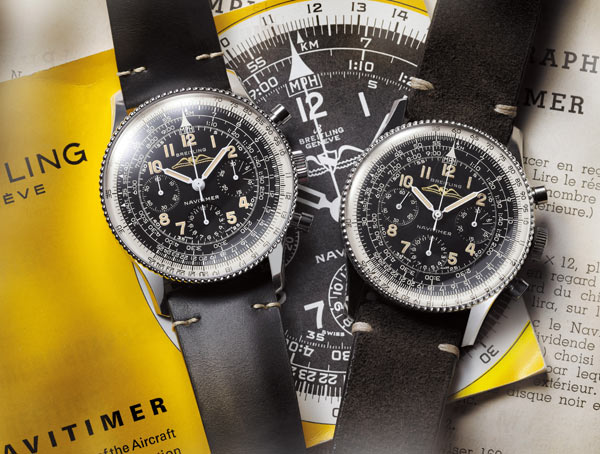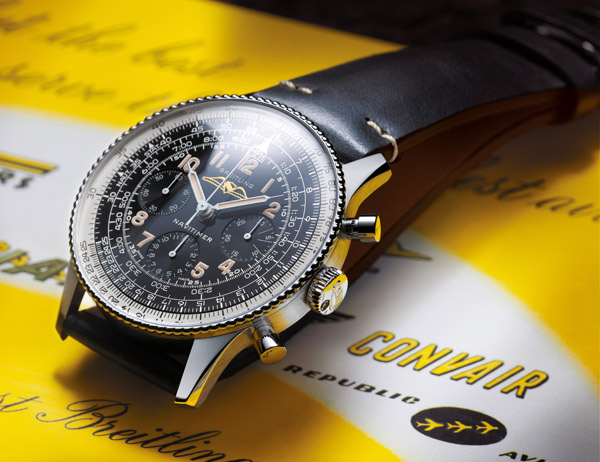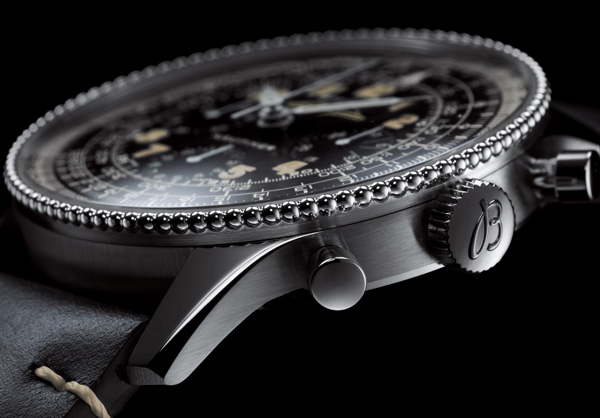When iconic watches are re-issued for a modern audience, concessions are often made to take into account the changes in trends and tastes in watches that have occurred over the decades since the original watch was released. The case may be made larger, the design tweaked and the dial modified. But unlike most “neo-vintage” watches, the only concessions that Breitling has made with the new Ref. 806 Navitimer Re-Edition are the water resistance of 3 ATM and the use of SuperLuminova (but even this is in a pure vintage tone of beige).
I don’t need to go into the history of the Breitling Navitimer, since Serge Panczuk has already covered the brand’s iconic watch in depth. For this new Navitimer watch, Breitling has gone to great lengths to make the modern incarnation as close as possible to the original. Even connoisseurs will be hard pushed to distinguish the 2019 watch from the original 1959 Navitimer Ref. 806. The stainless steel case is the same 40.9 millimetre size as the original Navitimer, the beaded bezel has precisely 94 beads, just like the original, the lug profile is the same and the same all-black dial design is protected by a domed acrylic glass. A non screw-in crown, snap-on case back and vintage style black leather strap with pin buckle typical of watches from the period complete the true vintage style of this “new” Navitimer.

The re-edition of this Breitling Navitimer is so true to the original, in fact, that one could argue that it misses out on some subtle improvements to the Navitimer chronograph collection that have been made over the years, such as the contrasting red indicators on the slide rule and the better legibility of the white dial version seen on the Navitimer Cosmonaute. But this is not necessarily what Breitling fans are looking for, as Breitling CEO Georges Kern points out. “In the past year, we’ve been thrilled to learn that there are so many people who have always been passionate about Breitling’s legacy and that there’s enormous interest not only in our new products but also in our heritage and our early timepieces. The Navitimer Ref. 806 1959 Re-Edition will give new Breitling fans and people who have followed the brand for decades a chance to own and enjoy their own exclusive piece of our legendary past.”

Breitling has even developed a brand-new manual-winding chronograph movement for this watch, since the original also had a manual-winding chronograph movement (the first automatic chronograph was not launched until 10 years later, in 1969). The new calibre B09 is based on Breitling’s in-house automatic calibre 01 and is a COSC-certified chronometer chronograph. Breitling hints that this movement will also be used in future watches in what is likely to become a whole series of historical re-editions. Unlike the historical elements visible on the outside of the watch, the new movement inside the watch is bang up to date with a column wheel and vertical clutch and a power reserve of 70 hours.

So just how does that slide rule work?
What made the Navitimer watches famous was their circular slide rule, which added to the watch a means of performing all the calculations that were needed in aviation before the invention of modern autopilot and navigation systems. The black and white scales around the black dial may appear baffling at first, but take a few short minutes to learn how they work and it is surprisingly simple to operate. The original user manuals from the 1960s refer to it as a “computer” long before what we currently understand as a computer was invented. Before tackling your first calculations, note that there are two “indexes” on the slide rule: one at 12 o’clock (the hour index or ground speed index) and one at 2 o’clock (the units index). It’s also worth noting that calculations can be performed in multiples of ten based on the scales on the bezel.
Multiplication and division
If you want to multiply a number, turn the bezel until the number you want to multiply by is aligned with the 10. To calculate a multiplication by 12, for example, turn the bezel to align 12 on the outer scale with the units index 10 on the inner scale and read off the result on the outer scale (the same scale as the “12”). Take the number 7 as an example and you will see that the result is 84.
For division, the procedure is slightly different and we can use a less intuitive example to show the power of the slide rule. Let’s say you want to divide 120 by 4 (and your mind is on other things). Since the outer scale is only graduated from 10 to 95, you take the number 12 (since 120 is a multiple of 12) and turn the bezel until 12 aligns with 40 (also a multiple of 4). In this case, you read the result against the same units index of 10 and see that it is 30.

Speed calculations
Since speed is simply distance divided by time, the slide rule can also be used to calculate an aircraft’s ground speed. Turn the bezel so that the known distance aligns with the known time and the speed in miles per hour can be read at 12 o’clock against the “MPH” arrow. Given distance and speed, the slide rule can also be used to calculate the time it will take to cover the distance. In this case set the known speed at 12 o’clock and read the time on the inner scale alongside the corresponding distance. For example, if you need to cover 486 miles and you are travelling at 156 miles per hour, set the 156 (15.6) at 12 o’clock and read the time alongside 486 on the outer scale (48 in this case), which gives you 188 minutes, or 3 hours and 8 minutes. Additionally, speed in miles per minute can be calculated using the units index (10), which indicates 26, or 2.6 miles per minute.
Fuel consumption
Fuel consumption in gallons can be calculated if the rate of consumption is known. For example, if fuel consumption is 11.5 gallons per hour and the flight time is 3.5 hours, set 11.5 on the hour index at 12 o’clock and read total fuel consumption against 21 (210 minutes) on the inner scale: total consumption is 41 gallons.
Rate of ascent/descent
The time and distance of a climb or descent can also be calculated. To calculate the time of ascent if the rate and total elevation are known, set the rate at the unit index (10) and read off the time on the inner scale against the total elevation on the outer scale. Bear in mind that these figures will be multiples, so if the rate of ascent is 500 feet per minute use 50 and if the total elevation is 7,500 feet read off the time against 75, which is 14.8 minutes. The distance travelled in the same example can be used by setting the speed at the hour index (12 o’clock) and reading the distance on the outer scale against the time (14.8) on the inner scale, which gives a reading of 34.5 miles.
The slide rule also allows easy conversion between statute miles and nautical miles. Just set the statute miles aligned with “Stat” on the inner scale and read off the corresponding nautical miles against “Naut” on the same scale. The conversion to kilometres is also given alongside the “KM” marker just next to the MPH index at 12 o’clock.





